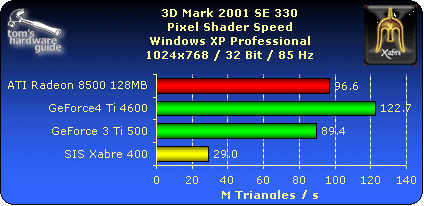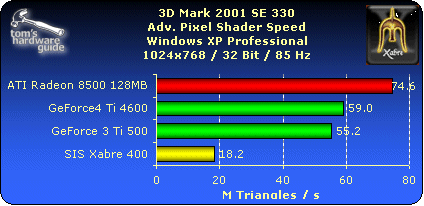Xabre Rattling - SiS's New Graphics Chip
Pixel Shader Speed
This test measures the speed of the pixel shader units. The standard test employs pixel shaders of the version 1.3. The advanced pixel shader test uses the version 1.4 as introduced by ATi, however. Obviously, the ATi cards are going to have an intrinsic advantage over the competitors here:
- Pixel Shader
Pixel shader is a technique for making custom per pixel lighting and other per pixel operations in a 3D scene. Bump mapping is a kind of per pixel operation, because it makes a surface look bumpy due to modifications of the pixel colors, without touching the scene geometry, or in other words the polygons of the scene. This test demonstrates a water surface drawn with a pixel shader doing environment bump mapping using a cube map. This test requires DirectX 8 compatible hardware with Pixel Shader 1.0 support. The graphics card needs to be capable of 4 texture layers in a single pass to produce this water surface in a single pass. - Advanced Pixel Shader
This is a new test included in 3DMark2001 SE, and it uses Pixel Shader version 1.4, introduced in DirectX 8.1. The same effect can also be achieved using Pixel Shader 1.0, but then rendering the water surface requires two passes. Graphics hardware that supports Pixel Shader 1.4 (or higher) render the water in a single pass. The water surface in this test is more realistic than in the test above. Instead of just an environment bump map reflecting a cube map, this test uses a ripple texture (traditional environment bump map), a reflection texture, a refraction texture and a Fresnel texture. The resulting effect is a water surface that has ripples from for example the wind, shows a rippled reflection and a rippled refraction (view of objects beneath the water surface) + the reflection intensity is adjusted according to the camera's angle to the water surface. For example looking perpendicularly at the water surface will show only refracted light rays, or what's under the water surface, and looking almost parallel to the water surface will show the reflection only.
The Xabre400 falls behind noticeably in this test, and it becomes apparent that it can't really keep up with the "big" DirectX 8 cards, although at 250 MHz their GPUs are clocked only marginally faster than the GeForce3 Ti500's. It should be noted that the Radeon 8500 leads the GeForce4 Ti4600 by a mere 15fps in the advanced pixel shader test. This is interesting because, unlike the NVIDIA card that supports only PS 1.3, it can process PS 1.4 computations in one cycle. Another interesting phenomenon is the GeForce4 Ti's meagre lead over the GeForce3 Ti in this test.
Get Tom's Hardware's best news and in-depth reviews, straight to your inbox.

